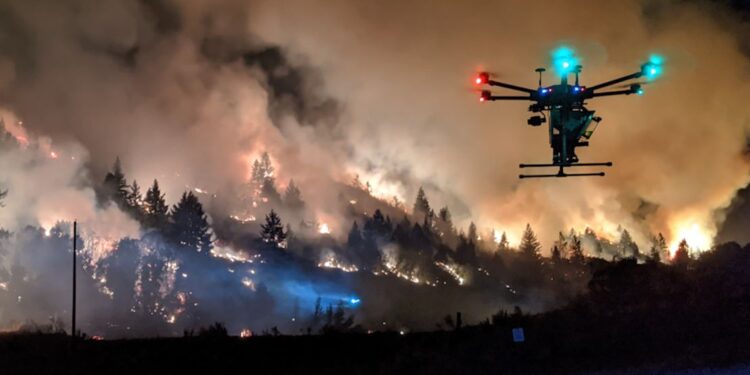British Columbia’s most intense wildfire week of 2025 brought a Canadian milestone. As flames tore through the province in late June, officials deployed a fleet of AI drones at scale to map, track and suppress blazes in real time. Designed by SkyScout AI, the system showed how next generation tools can shift wildfire response from reaction to prediction, giving firefighters a critical edge in fast changing conditions.
Founded in 2023, SkyScout AI blends satellite heat detection, machine learning analysis and two classes of autonomous aircraft. Scout drones locate ember hotspots with thermal vision and on board mapping. Tanker drones follow digital markers, releasing water or non toxic retardant such as Citrotech® with centimetre level precision. A central command algorithm synchronises the fleet, enabling 24 hour coverage in mountainous terrain where crewed aircraft struggle to operate safely.
How SkyScout AI’s Drone Fleet Works
During the late June surge, provincial authorities activated SkyScout across several zones where ground crews were stretched thin. Scout drones spotted hidden flare ups within minutes, relaying live perimeter maps to incident commanders. Tanker drones then executed pinpoint drops that helped contain spot fires before they merged into wider fronts. CTV News footage showed drones weaving through smoke to reach isolated ridges beyond the reach of water bombers. Emergency officials said the system averted at least two potential blow outs near Port Renfrew and Lillooet.
Wildfires cost Canada an estimated 4.4 billion dollars in 2023, a figure expected to rise as climate change intensifies drought cycles. Traditional suppression faces limits in speed, visibility and crew safety. AI driven drones offer continuous surveillance, early ignition alerts and immediate response without risking human pilots. Analysts argue the British Columbia trial proves autonomous systems can protect remote forest tracts more effectively than conventional tools alone.
From BC Trial to National Wildfire Strategy
The successful rollout has accelerated policy talks in Ottawa about scaling autonomous public safety technology. Transport Canada recently broadened permissions for night flights on active fire lines, clearing a path for SkyScout’s intervention. Federal officials are now studying dedicated funding for AI disaster response, while provinces explore permanent drone integration. SkyScout AI is negotiating pilot programmes in Alberta and Northern Ontario, both bracing for hotter, drier seasons ahead.
SkyScout’s mission is more than early warning. By combining high fidelity mapping with autonomous suppression, the company offers a blueprint for faster, safer and more cost-effective firefighting. As fire seasons lengthen, such systems could become essential to national resilience. June’s operation showed AI can move beyond prediction and take decisive action. With sustained investment and clear policy, Canada could lead the world in applying AI to climate defence when lives and landscapes are on the line.












